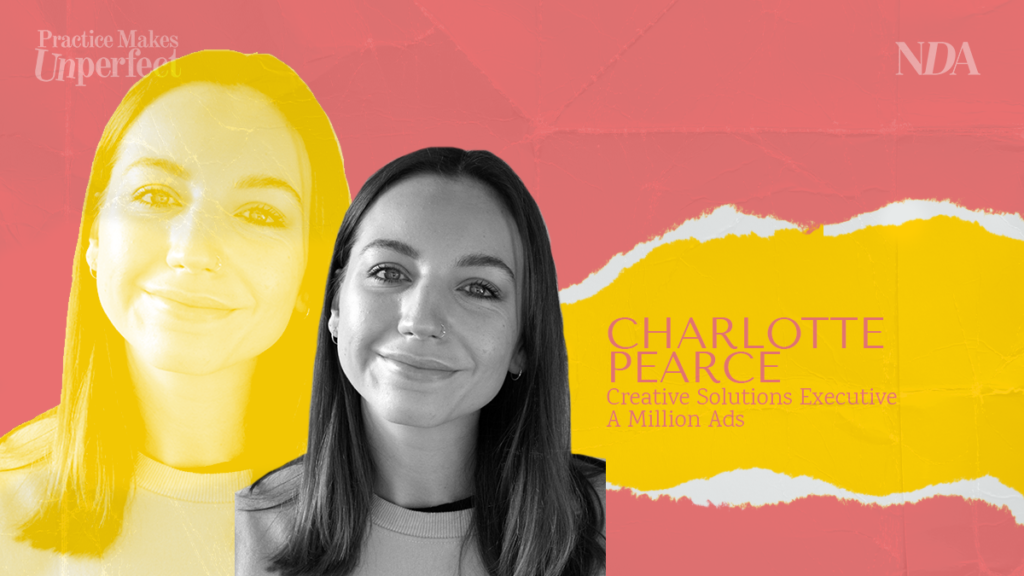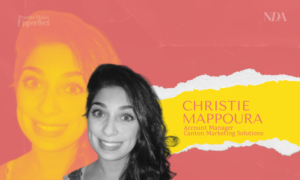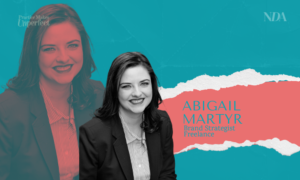By Charlotte Pearce, Creative Solutions Executive at A Million Ads
These articles have been written by the latest cohort of the Practice Makes UnPerfect programme – a course that helps women find and finesse their public voices.
‘Why are you sending that as an email when they’re sitting opposite you?’
As a naive nineteen year old in my first role at a media agency, I asked my line manager this almost immediately, having spent a day or so observing the ways of the corporate world. I found the way people communicated confusing, and it was worlds apart from my last not-so-corporate job at Nandos. We didn’t just serve with a smile, we did everything through human interaction.
The second thing that blew my mind in my shiny new adult job was how many agencies are involved in the creation of one single (let’s face it, probably pretty basic) advert. Third parties, ad tech, media agencies, creative agencies, the client, publishers, DSPs, SSPs…the list goes on. There were many more media rituals that perplexed me, but the point is that both of these things make work less effective and relationships are watered down to the point of becoming less human.
Five years later – now working in Creative Solutions at A Million Ads – and I’m still confused by the unnecessary complexity of digital. Working in ad tech has provided me with a front row seat watching media agencies, creative agencies and the client interact. Somehow, my colleagues and I regularly slip into the role of counsellor in a rather intense love triangle, sitting between the media strategy and creative output to try and make sure everybody’s needs are heard, and met. Yet still, there exists a severe lack of communication between each party.
Why do media agencies and creative agencies remain segregated? My guess is that the answer lies in the age-old data vs creativity debate, which has been discussed, at length, for decades. It’s even rumoured that some media agencies have data rules graffitied in the office toilets. The longer the debate manifests itself across Linkedin in the form of a quirky article, the longer media agencies and creative agencies will stick with what they know. Fear of the unknown will keep us safely within our comfort zones and job titles.
Take media agencies, for example. Nouman Ali from Dynamologic Solutions stated that “data and other tech tools are there to help create an impressive campaign. However, depending only on data to do its magic is where it could all go wrong.” Therefore, it’s clear that data (in some cases) has become some sort of fabergé egg presented to the client – impressive rather than useful. All-encompassing at the expense of creativity.
But perhaps we’re still spending far too long talking and not long enough reaching compromise. It’s not about the debate – it’s about the outcome. Working in an industry that combines both data and creativity together has shown me that results are far better when these two are synchronised as opposed to separated.
At A Million Ads we’ve found that conversions are more than doubled when using data and creativity in dynamic personalised ads. Nick Manning, founder of Encyclomedia International said recently that clients are diversifying their agency rosters and seeking news models – often abstaining from multiple parties. They expect agencies to collaborate.
To make this happen, we need to work as one central hub. Things have been slowly progressing in this direction – clients like Sky, BBC and Specsavers have their own in-house creative agencies to streamline processes. Creative teams inside media agencies have also been introduced – Wavemaker have their own creative content team called WM Studio, and Mediacom have Creative Systems which is a new division implemented in order to bring media and creative back together to boost growth for clients. So why aren’t things improving? As always, it’s about getting the foundations right – Deacon Webster CCO at Walrus believes that the more upstream creative and media work together, the better the results will be.
But how can we get there? Egoless working is a good start. consider bringing your relevant teams together (be it virtually or in real life) when thinking about campaign strategies in order to remove competitiveness. Brian O’Neill said in his podcast Experiencing Data that having everyone in the same room is the most effective way to create innovation for your client – one idea might spawn someone else’s idea in the room, and you end up building one idea up until it’s at the height of it’s ideation.
And think outside (of the outside) of the box! Recommend both data and creative ideas based on what the client needs versus what you’ve done in the past for similar clients. Yes, clients are interested in what their competitors are doing, no they don’t want carbon copies.
Finally, agree upfront on what everyone’s version of innovation is. If we were clearer about our feelings and how we communicate, what our expectations are and what we want from these relationships, we’ll have less love triangles and more virtuous circles. And maybe I could even resign my job as a relationship counsellor (via email).









